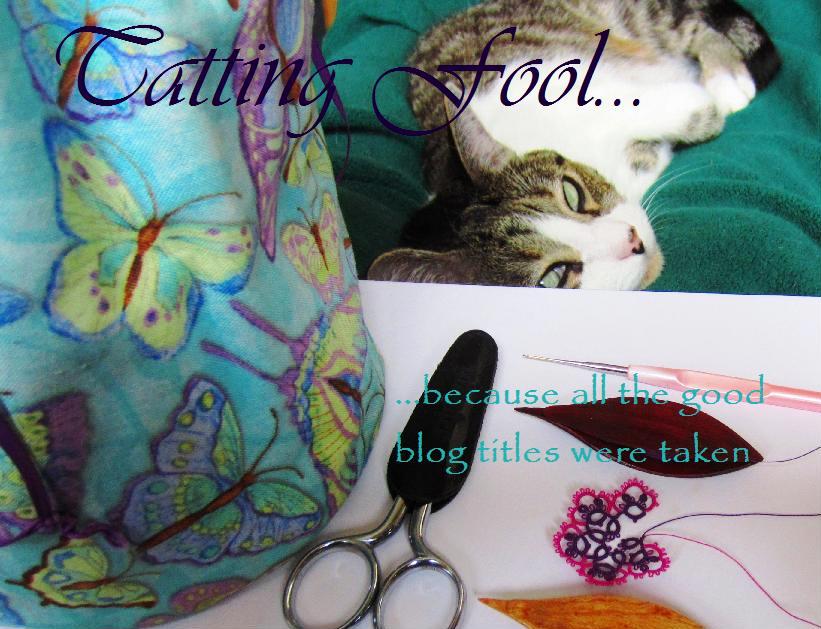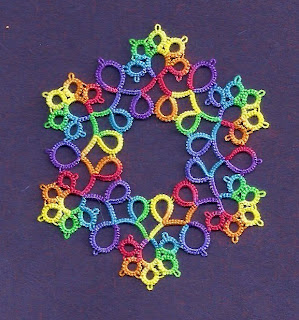The same issue seems to be coming up on several blogs and tatting lists lately. If I'm making an edging that I want to attach to a pre-made fabric center like a hanky or doily, how do I know that the edging will fit? It seems that this question gives a lot of tatters fits, while others simply start tatting and hope for the best (and this often works, too). I've seen many tatters say they are "not math people". I suspect that this is at least partly because the majority of tatters (and all of the ones that I've seen that phrase from) are women, and there was a time when girls were commonly told that they were naturally not as good at math as boys were. I've even heard of girls in decades past being told not to bother taking algebra in high school because as women they wouldn't need it! Never mind that women were largely responsible for doing the household accounts; it obviously didn't occur to these people that math is necessary for the traditionally feminine pursuits of sewing, quilting, and fitting a tatted edging to a fabric center. And of course, heaven forbid a woman should want to be an engineer, but that's a rant for a different day.
I was lucky enough to be born in an era and a family where I was never told that girls couldn't do math, so I've always enjoyed it. OK, there might have been a year or two in high school when I wouldn't admit to it, but I still to this day blame a certain teacher for that. Trigonometry was the only form of math that I never "got", and it was specifically because this teacher was such a royal ***** that I simply refused to learn from her. Other than her, though, all of my math teachers were wonderful, enthusiastic, dedicated, encouraging, made a point of calling on girls and boys equally, made it fun, and made you see the real-life applications of it. I was very lucky.
Then, of course, some people simply dislike math or have trouble with it, even if they've never been discouraged. Also, I do not mean to exclude my male tatting friends from this discussion.
As it turns out, calculating how many repeats of an edging to make is really quite simple if there are no corners; you learned how to do it before you got to the "girls don't need that" kind of math. You tat a sample of the edging, measure the outer edge of what you are trying to fit the tatting to, measure the inside length of one repeat of the edging, and divide. Here's an example:
I made this doily a couple of years ago; the center is from
Handy Hands and came with pre-made holes so that the tatting could be joined directly to it for those of us who hate sewing. The edging pattern is
"Fleur-de-Lys Edging" by Tat-Man Mark Meyers, and the thread is "Vanilla Sky" by
Tatskool.
So here's the math. Since the doily had pre-made holes, I didn't even need a tape measure; I simply made "holes" my unit of measurement. There are 120 holes around the edge. I made a sample and found that one repeat of the edging was 5 holes long. This was easy: 120/5=24. Therefore, I needed to make 24 repeats. See, you can do this. Incidentally, I'm sure that the doily manufacturer chose the number 120 on purpose because it is divisible by a lot of different numbers, so an edging with almost any length of repeat will fit evenly around.
If you are using fabric that doesn't have pre-made holes, you still do the same thing. Measure carefully around the edge with a tape measure, and measure the length of one repeat; be sure to use the same units for both measurements. So if the doily is 36 inches around and one edging repeat is 2 inches long, 36/2=18 repeats.
For a piece with straight sides and corners, the math is slightly more complex but still very do-able. Tat a swatch of edging that includes at least one straight repeat and a corner. Measure along one side of the fabric; we will call this number F. Measure the inside length of the straight repeat; we will call this number S. Also measure the inside length from the start of the corner repeat to the actual corner; we will call this number C. Now we can create a formula to find out how many straight repeats you need on this side; the number of straight repeats will be x, the number we are trying to find. There are 2 corners per side, so we need to multiply C
by 2. Thus the formula is:
2*C + S*x = F
(I'm using the asterisks to represent multiplication so as not to confuse them with the variable x. There are a number of different "correct" ways to represent multiplication in algebra, but I'm going to use this for consistancy.)
To plug in real numbers, let's say that F, the length of the fabric edge, is 15 inches. Suppose that S, the length of one straight repeat, is 1 1/2 inches. And say that C, the length from the start of the corner repeat to the actual corner, is 3/4 inch. It's easier (I think) if you convert the fractions to decimals. Thus we have:
2*0.75 + 1.5*x = 15
The first thing to do is to simplify the equation by doing any basic arithmetic funtions that we can; in this case, multiplying the 2*0.75. You are allowed to use calculators in my class! This gives:
1.5 + 1.5*x = 15
Now we're going to get rid of the lone 1.5 by subtracting it from both sides of the equation:
1.5*x = 15-1.5 =
13.5
Finally, get rid of the other 1.5 (which was S) by dividing both sides of the equation by 1.5:
x = 13.5/1.5 =
9
You need to make 9 straight repeats along this side. If another side is a different length, do the same calculation for that side. This method will work not only for squares and rectangles, but for any polygon; you just have to do the calculation for every different length of side.
Obviously, I have deliberately chosen numbers that result in a whole number of repeats. In real life, it won't always work out that way. If you get something that's very close to a whole number, like 8.9 or 11.2, you can choose to attach the completed tatting by sewing or crocheting, rather than joining as you tat. Then you can stretch or scrunch the tatting a little bit as you attach it to make it fit. Or you can try using a different size of thread; this will change the values of S and C in the formula and give you a different result. Or you can change the size of the fabric by either trimming a bit away and re-hemming it or sewing an additional strip of fabric along each side. Or you might have to choose either a different fabric center or a different edging to come up with numbers that work.
Regarding the tatting itself, if there are no corners to turn and your calculation resulted in a whole number of repeats without having to do any stretching or scrunching, you can either join directly to the fabric as you tat, or attach it later by sewing or crocheting; there are arguments to be made either way. If there are corners, then I highly recommend attaching the tatting after it is completed; that way you don't have to worry about starting in exactly the right spot to make the corners line up.
Some people will be tempted to tat their sample using a cheap thread, thinking that they are being thrifty. Do not succumb to this temptation! You should always tat your sample using the same thread that you plan to use for the real thing. As we all know, the "same" size of thread made by different manufacturers will often tat up differently; this is especially true with cheap threads. Then your measurements will be off, and all your calculations will be useless. Don't think of your sample as a waste of thread; instead it is a valuable step to making a beautiful finished product-- and think how much more thread you will have wasted if you get almost to the end of your project only to find that it's not going to fit. And of course, if it's an edging with more than one round, you only need to tat the innermost round for your swatch.
I hope that I have managed to demystify how to calculate fitting an edging to a piece of fabric, and have not confused you even more. If you still need help with this or any other tatting math, or if you want to send me hate mail for making you think about it, please feel free to
e-mail me.











